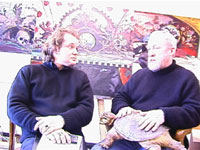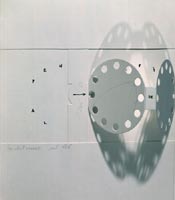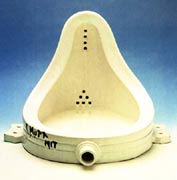"A very normal guy" Robert
Barnes on Marcel Duchamp and Étant Donnés
Tout-Fait: So that's a quality he could appreciate. Robert Barnes: He could appreciate that in anybody. Well, look at the people he liked. He did not have great taste in art. He loved a guy named Cremonini. Well Cremonini was a terrible artist. He was Italian and did those kind of long neck people with scrubby faces that didn't have features.
Tout-Fait: Why do you think that he liked that kind of thing? Robert Barnes: Well he liked him. He would have him over. Tout-Fait: Well that's always what he said. Look at the individual and not the art. Robert Barnes: Well Cremonini was not likeable either. He was very conceited. Knobby head, that was very popular in those days and everyone did that. I think maybe one of the best and the worst thing Marcel offered people was a lack of discrimination. He didn't discriminate. In doing so, he made the world easier, but by opening up, eliminating, abolishing decision-making tactics in deciding what is art, I think he created a terrible disaster. Because we don't know what the hell we are doing, there are no standards. The standard now becomes fame or money, neither of which Marcel really cared about. He liked it but he did not ever pursue it. As a result, we have all of these people who want to be seen, and Marcel never wanted to be seen, he almost had to be picked out of life to be seen. I think, I don't know what he would think if he were alive today, be amused, because he didn't discriminate. He had this idea once, it comes from a conversation we had so I don't know if it ever got said again. He wanted to know if we could decide what is art by having a vote. Have you ever heard that idea of his? Tout-Fait: No. Robert Barnes: Well he was going to have a world vote and everyone in the world would vote on what is art. Tout-Fait: So they would get a little questionnaire? Robert Barnes: Yeah and maybe something, pictures or something, but he thought it would be too hard to find pigmies and so he decided the only way to really get a democratic view of what art is was to have his questionnaire circulated in barber shops. In those days barbershops were not hair salons, they were just barbershops. You read dirty books and magazines and bought rubbers and it was easier than going to the drugstore. He liked those places and he thought that was probably the most democratic. Tout-Fait: Only men would go there though. Robert Barnes: Well I suppose he might have let the beauty parlors do the same thing. But that's how he'd find out what art was. Tout-Fait: Did anyone follow up on that? Robert Barnes: No, you didn't need to. The idea was good enough. Tout-Fait: At the time you met him, most of the ready-mades were already lost, they only existed in old pictures, he made or bought a few reproductions in the1950s, then he came out with this edition in 1964 collaborating with the Milanese dealer and scholar Arturo Schwarz. Do you have any thoughts on the 1964 edition of the ready-mades?
Robert Barnes: First of all, the ready-mades were always being readymade around Marcel. I mean, things were always being put together or glued, like the spoon on the doorknob (Fig. 15) (8). You don't seem to come across any mention of the antlers at the top of the stairs. Tout-Fait: No, what about those, what stairs? Robert Barnes: Well they were right at the top of the stairs of his apartment near Bloomingdale's on the East side. And that's the apartment that had the great mailbox, Duchamp, Matisse, and Ernst. Art history's mailbox, really. At the top of the stairs was a set of antlers, really at a dangerous height, so you were always afraid that somebody would come up too fast and get impaled but I think that was the purpose. Tout-Fait: You could hit your head? Robert Barnes: It was right about here [motions in front of his chin]. You sort of had to get around it. I remember another thing Duchamp had made. One time he had a way of telling what time it was with the help of mirrors. Either the clock was outdoors or indoors, I can't remember where the clock was. But he had one mirror at the clock, there's another that would reverse, and then there's another that would reverse it back.
Tout-Fait: Well he wrote that note of a clock in profile that you can't tell the time from a clock in profile (Fig. 16). Maybe the idea with the mirrors circumvented that somehow. Did he have that installed in his apartment? Robert Barnes: Yes. Tout-Fait: Only temporarily? Robert Barnes: I don't remember what happened to it. Tout-Fait: How many mirrors? Robert Barnes: Three or five. It had to be an odd number. Tout-Fait: From a clock tower? Robert Barnes: No I don't think so. I don't know where the clock was. I'm old. That was forty years ago. Tout-Fait: But what did he do with the antlers. What was the thing with the antlers? He just had them there? Robert Barnes: Well it was in the hallway outside of the door. Tout-Fait: Were things hanging from them? Robert Barnes: No. It would be great to hang things from. His house was always filled with odd little things set up. They all did it. Matta did it too. Tout-Fait: But the ready-made edition in 1964, why did he do that? Robert Barnes: I was mad about that. Tout-Fait: You were not in New York anymore? Robert Barnes: No I was away. And I said to him, "What on Earth possessed you?" Everyone thought that Arturo Schwarz initiated it as a moneymaking venture. I don't know maybe it was moneymaking. It certainly would be for Arturo. Tout-Fait: You went to Duchamp, you approached him, and you asked him this? Robert Barnes: Yeah, I said that I couldn't understand why he did it. And he explained that it was... I mean, I can make a parallel between the bride in The Glass and the bride fleshed out in Étant Donnés. It goes full circle. The bride is not fleshed and then becomes flesh. With the ready-mades, they were junk and their traversing of time brings them to commercial objects. He told me he was going to have the opening in Macy's, but I think he was joking or didn't know it, because they didn't do it. Tout-Fait: So when you asked him, what did he say why he did it? Robert Barnes: That's what he told me. It was a perfect transit of the readymade from discovery to the crassness of just being a commercial object and it is very interesting that something that was nothing becomes something by our commercial standards, and we judge by money. I mean we were discussing his urinal today. How much did you say that sold that for?
Tout-Fait: An example of the 1964 edition (Fig. 17) went for a little bit above $1.76 million in November 1999. Robert Barnes: That wasn’t even the original. Here’s a thing where an idea becomes $1.6 million. Tout-Fait: $1.76 million. Robert Barnes: The traversing of time, and everything in Duchamp was about the process of transit, it brought a piece of junk toilet to someone who’s very wealthy or a museum’s halls. But it is still worth nothing. But someone paid one point something million.
Notes
Figs.
15-17
|
















